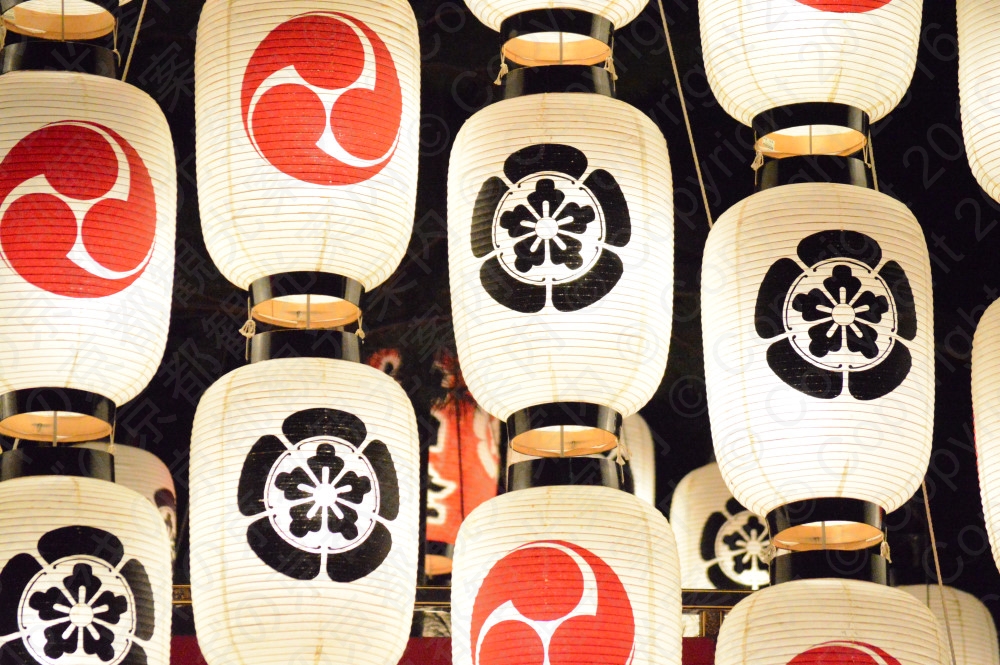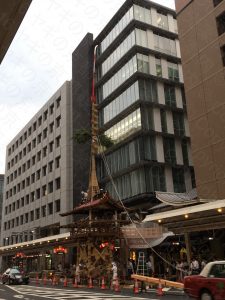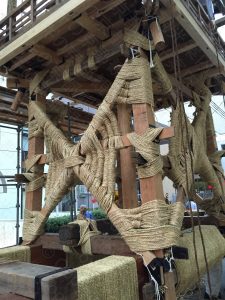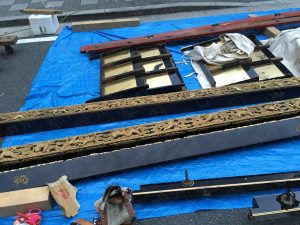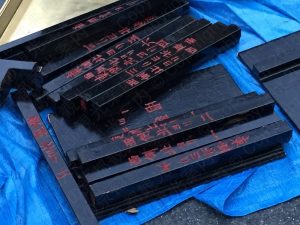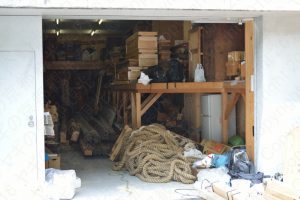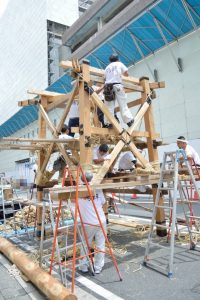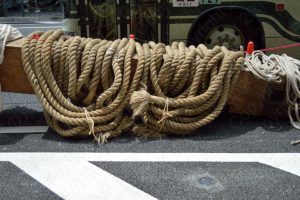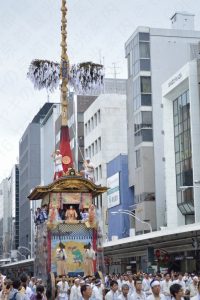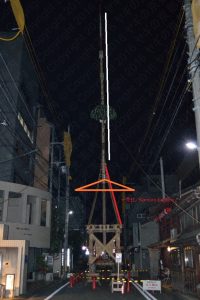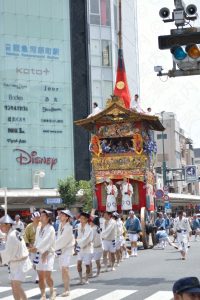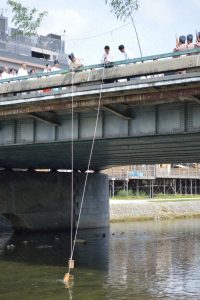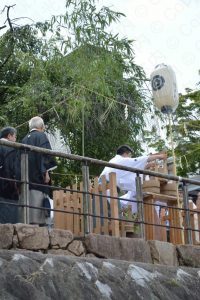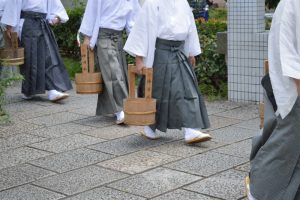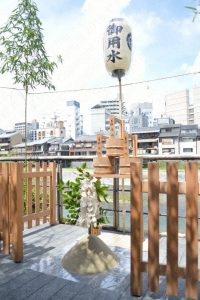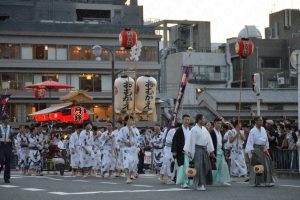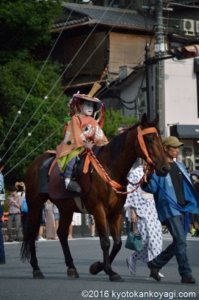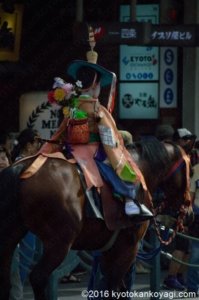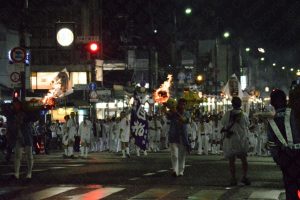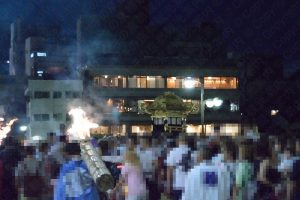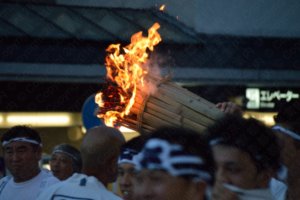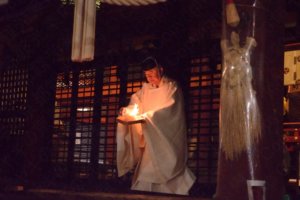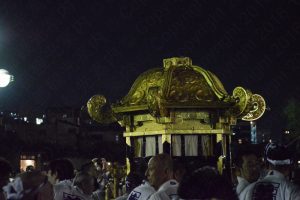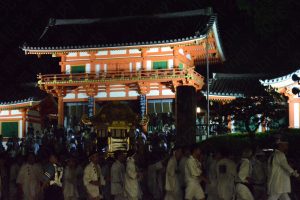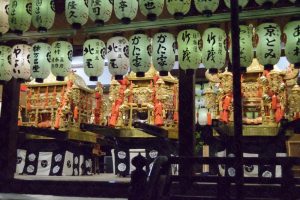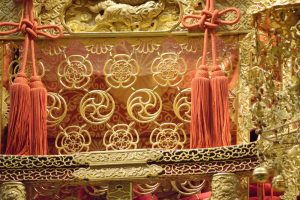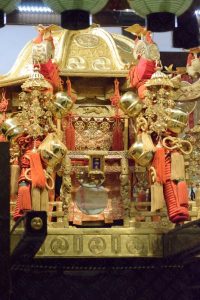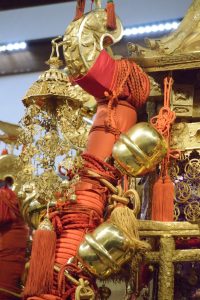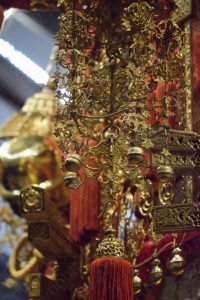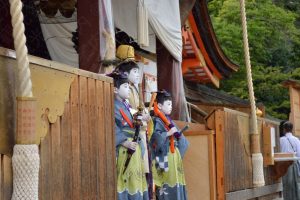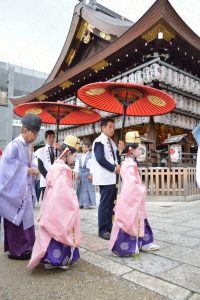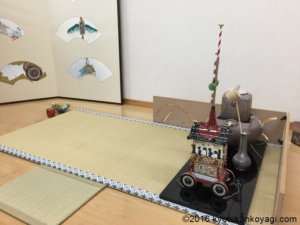THE GIST OF THIS ARTICLE
- Page 1 Intoroduction, Schedule 2025
- Page 2 Chinowa Kuguri, Chogomai, etc.
- Page 3 Hokotate, Omukae Chochin, Mikoshi Arai, etc.
- Page 4 Saki Matsuri Yoiyama
- Page 5 Samurai Armor exhibition, Yoimiya Sai, etc.
- Page 6 Saki Matsusri Yamahoko and Mikoshi parade, etc.
- Page 7 Ato Matsuri Yoiyama and Abare Kannon, etc.
- Page 8 Ato Matsuri Yamahoko parade, etc.
- Building Yamahokos, (鉾建て)10th July Strongly recommended
- Purification of water for rituals (神用水清祓式), 10th July
- Reception with paper lantern (お迎え提灯), 10th July
- Purification of portable shrine (神輿洗式), 10th July
- Hikizome, (曳初め) 12th July
- Hikizome, (曳初め) 13th July
- Iki-Chigos of Nginata boko pay a visit to Yasaka shrine. 13th July
- Kuze Komagata chigos pay a visit to Yasaka shrine. (久世駒形稚児社参) 13th July
- Kikusuiboko Chakai 菊水鉾茶会 13th~16th(Usual year)
Building Yamahokos, (鉾建て)10th July Strongly recommended
The construction of Hoko
They start to built Yamahokos of Sakimatsuri. The construction of Yamahokos are very simple. Builders put wooden pillars together with only ropes.This art is called nawagarami (縄絡み). NO nails are allowed. Only ropes are available.
These are parts of Niwatorihoko. Take a look at black wooden blocks. Red Kanjis are written on them. The Kanjis indicates where each blocks ought to be. These blocks make diagrams for construction. For example, the Kanjis on the block in the bottom of the picture indicate “On the north side of the east face (of Yamahoko), 6.”
The parts of Yamohoko are in the warehouse near the headquarters.
The construction workers building the Niwatori-hoko with ropes and wedges.
These are the pictures of Kikusui hoko. Hoko has long horn called “Shingi (真木)”. The white line in the second picture stands for it. It is so long and heavy that hoko has pillars called “Kamuro bashira” (禿柱, in red line in the picture) which hold Shingi.
On the other hand, some Yamas don’t have the Kamuro bashira. Kita kannnon yama resembles in appearance, but different in construction.
The ill-balanced construction make hokos swing when they march.
The following are the dates each Yamahoko-building starts

Schedule
| Saki Matsuri 前祭 | |
| 9th | Naginata Hoko長刀鉾 |
| 10th | Kanko Hoko函谷鉾 |
| Niwatori Hoko鶏鉾 | |
| Kikusui Hoko菊水鉾 | |
| Tsuki Hoko月鉾 | |
| 11th | Fune Hoko船鉾 |
| Hoka Hoko放下鉾 | |
| Iwato Yama岩戸山 | |
| 12th | Hosho Yama保昌山 |
| Hakuga Yama伯牙山 | |
| 13th | Ashikari Yama芦刈山 |
| Urade Yama占出山 | |
| Yamabushi Yama山伏山 | |
| Arare Tenjin Yama霰天神山 | |
| Kakkyo Yama郭巨山 | |
| Hakuga Yama伯牙山 | |
| Ashikari Yama芦刈山 | |
| Abura Tenjin Yama油天神山 | |
| Tokusa Yama木賊山 | |
| Taishi Yama太子山 | |
| Hakurakuten Yama白楽天山 | |
| Ayagasa Hoko綾傘鉾 | |
| Toro Yama蟷螂山 | |
| 14th | Moso Yama孟宗山 |
| Shijo Kasahoko四条傘鉾 | |
Purification of water for rituals (神用水清祓式), 10th July
Shinto priests of Yasaka shrine head for the river Kamo by way of Chugenji temple. On the Shijo bridge, they draw the water with traditional buckets. The water is called Shinyo-sui (Water for Kami) . Priests bring the water to the altar on the river bank and purify it with their prayers. In the evening, portable shrine is purified with it.
Shinto priests purify water to wash a Mikoshi. They draw water with bucket on the Shijo bridge. The water was put into small wooden tubs and the priests take anything evil from the water.
Reception with paper lantern (お迎え提灯), 10th July
General
About 350 persons march around the area of ancient Kyoto city and prepare for the portable shrines.
Umaosa 馬長
In ancient times, emprors and aristcrats enjoyed to see Gion Goryo-e with Umaosa.
Umaosa is a child on horse back. Before Yamaboko was invented, it is the most popular thing in Gion matsuri.
Sagimai dance performance 鷺舞(さぎまい)/鷺踊
As described before, an artist give birth to Sagimai as a developed form of Sagi Odori.
Purification of portable shrine (神輿洗式), 10th July
In 2022, Mikoshi Araishiki was held at Yasaka shrine.
Mikoshi, a portable shrine heads for the Shijo bridge. Gion matsuri festival has 3 mikoshis and one of them, “Nakagoza” is purified on the Shijo bridge. It is purified there with the water the priests draw in the morning. After the torches, the portable shrine moves toward the bridge.
First of all, the huge torches depart from Yasaka shrine. They make their way to Shijo bridge purifying the road where the portable shrine goes.
These torches are lit up with Okerabi (朮火). Okerabi is fire and is made on 28th of December every year at Yasaka shrine. The fire is kept burning in main hall of the shrine and used in many rituals.
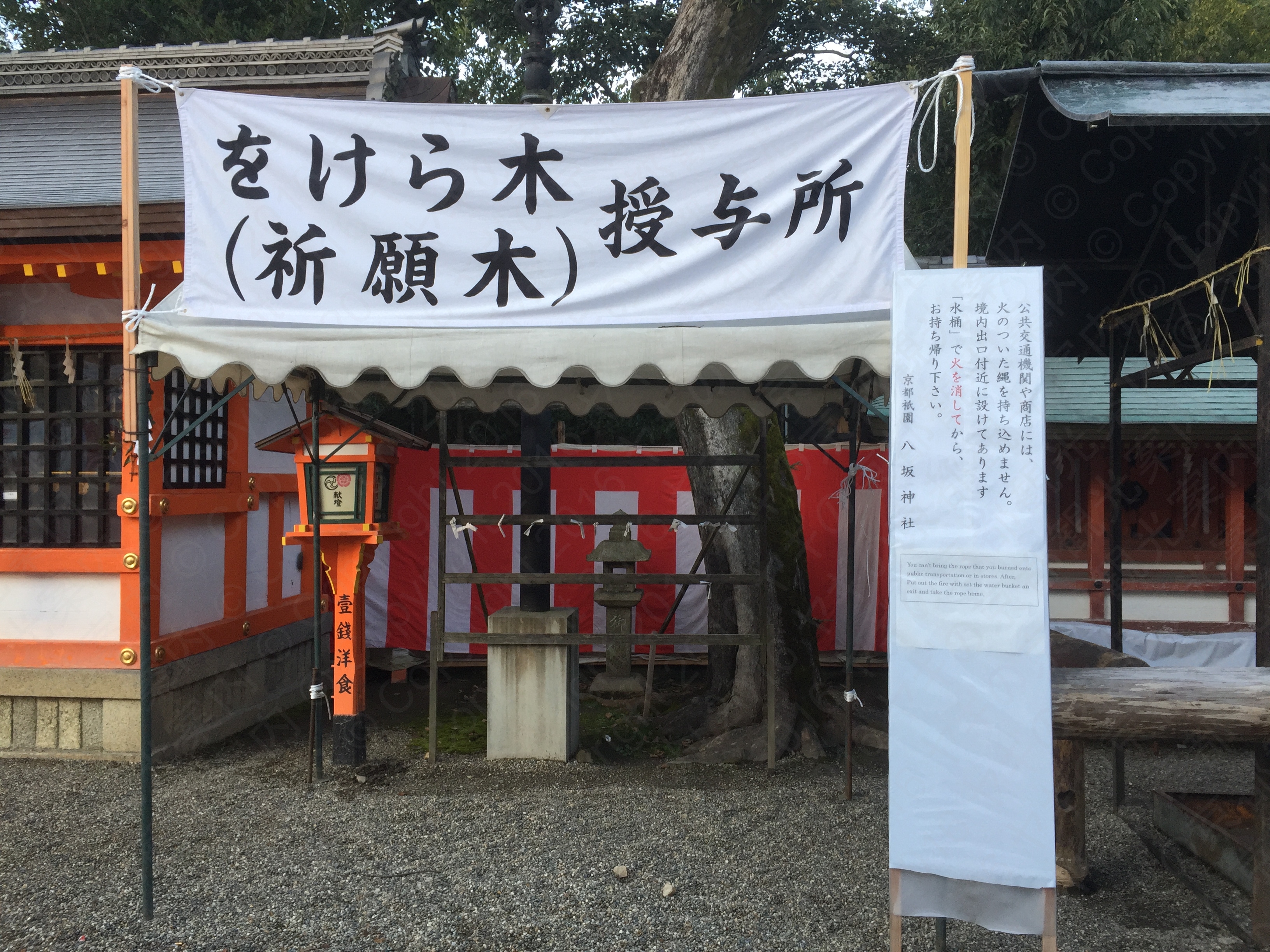
You may see the charcoal dropping from torches on the road. It saves you from bad luck.
The portable shrine was purified with the water on the bridge. Mikoshi is decorated with many ornaments but “Nakagoza” on this occasion doesn’t have them. It is very rare to see “raw” mikoshi.
After the purification, Nakagoza goes back to Yasaka shrine.
On the return to the shrine, Nakagoza was ornamented right now. We can see fully dressed Mikoshis at Yasaka shrine for a week.
Hikizome, (曳初め) 12th July
After the Yamahoko-building, Naginata Hoko, Kanko Hoko, Niwatori Hoko, Kikusui Hoko, and Tsuki Hoko have test-runs. On this occasion, anyone can trail Yamohokos. (I trailed Kikusui-hoko and Naginata-hoko actually!)

On 12th
- Naginata Hoko 長刀鉾・・・15:30
- Kanko Hoko 函谷関・・・14:00
- Niwatori Hoko 鶏鉾・・・14:30
- Kikusui Hoko 菊水鉾・・・15:00
- Tsuki Hoko 月鉾・・・15:00
Hikizome, (曳初め) 13th July
Hoka Hoko, Fune Hoko, and Iwato Yama have test-runs on 13th.
- Hoka Hoko 放下鉾・・・15:00
- Fune Hoko 船鉾・・・15:00
- Iwato Yama 岩戸山・・・15:00
Iki-Chigos of Nginata boko pay a visit to Yasaka shrine. 13th July
Iki-Chigo (生稚児) is a boy considered and treated as a messenger of Kami (The center of the boys in the picture above.The boys of the both sides are kamuros.) He ride on the Naginatahoko on the day of Yamaboko float parade. On the day, there is a rope which divides sacred and secular world. He cut off the rope and the parade starts.
In the days of old, many Hokos have Chigo but only Nginataboko has Chigo these days. Other Hokos have Chigo figurine instead.
This visit is called Okrai morai because the shrine give him the same ranking as the feudal road.
Kuze Komagata chigos pay a visit to Yasaka shrine. (久世駒形稚児社参) 13th July
We have another Chigos. These boys called Kuze Komagata Chigo (久世駒形稚児). On the day of Mikoshi parade. They are treated as Kami himeself because they has Goshintai (An object which Kami descends to ) of Ayato Kuninaka shirine (綾戸國中神社).
Kikusuiboko Chakai 菊水鉾茶会 13th~16th(Usual year)
From 13th-16th(usual year), tea parties are held at Kikusuiboko Kaisyo. We can have a plate on which Wagashi is.
ヤギの京都観光案内/KYOTO GOAT BLOGをもっと見る
購読すると最新の投稿がメールで送信されます。

